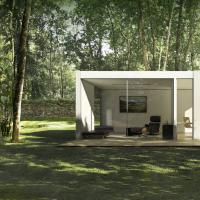Millenials are less likely to own a home than their parents were at their age. A lack of affordable houses can erode a sense of community, making finding that community spirit difficult.
That’s why one millenial, Trish Becker-Hafnor, created Chase Street Commons — it’s an affordable, community-style approach that seeks to foster community living in northwest Denver, a tiny village contained in an acre of land.
“As a generation, we’re realizing that what we’ve built doesn’t actually work for anyone,” says Becker-Hafnor, a social worker at the University of Denver and the brains behind the cohousing project.
“We crave something different, so we’re looking for creative ways to live together and we’re finding creative ways to build that into our own lives.”
Two problems, one possible solution
More than half of all baby boomers owned homes by age 30. For Gen Xers, that number dwindled to 48%, and for millennials, it’s 42%. Meanwhile, the average age of a first-time home buyer rose to 55 years old in 2020, an all-time high. A lack of affordable housing is a problem, and the problem is more and more pronounced for each subsequent generation.
And for those millennials who do end up getting their suburban, stereotypical American Dream home, they can find it is not always what they envisioned — like they needed to create their own Dream.
“As we started to feel really lonely and isolated in the suburbs, it felt like we traded in community and relationships for the big house,” Becker-Hafnor says. “We didn’t want to raise our kid, alone, in a big house in the suburbs.”
Becker-Hafnor’s solution is coliving. Instead of single-family homes, cohousing families reside in apartments or condos (often called cohousing developments) or planned communities specifically designed to foster community.
What Becker-Hafnor’s American Dream looks like is a life filled with friendship, purpose, personal growth and a feeling of belonging.
Her new project is Chase Street Commons, a one-acre tract of land she’s trying to develop into a collection of affordable, communal spaces, inhabited by families who believe living in connection and community are the keys to a healthier, happier life. She calls it a “micro village.”
Chase Street Commons takes the communal living principles of a co-op (or similar cohousing structure) and applies them to a living arrangement that’s closer to traditional homeownership. In this way, Chase Street Commons is a more palatable form of communal living.
People can enjoy the connection afforded by a cohousing development while still owning their home.
At the moment, the parcel of land includes several abandoned homes. Becker-Hafnor’s plan is to convert them into a mix of private residences and shared spaces for the community. When finished, the multi-generational community will include up to five households. Cars will be allowed only on the perimeter of the property, with the interior filled with green space and walking paths.
Becker-Hafnor is also taking an innovative approach in making home ownership more financially accessible to families looking to join the community. The high cost of entry is one of the barriers millennials face to home ownership. Even if they can afford a mortgage, they may not be able to pony up for the down payment, for example.
Rather than having to come up with the traditional down payment for a home, which includes both the value of the home and the value of the land the house sits on, families at Chase Street Commons only have to come up with the down payment for the home.
The families then lease the land, with an option to purchase it at a later date. Even though the total monthly payments will be more in this model than traditional home ownership, it allows for a lower down payment which makes joining the community more accessible initially. In many parts of the country, the value of the land is more than the value of the house itself.
“We are trying to separate those two so folks only have to come with the money to pay for the home,” Becker-Hafnor says.
Rethinking how we live
Becker-Hafnor herself lives in a more traditional cohousing development called Aria Cohousing. It’s a former convent that was converted in 2017 into 28 condo units. She moved to the space specifically because she found living in the suburbs so alienating.
Traditional cohousing spaces like Aria are short on the creature comforts that we associate with traditional home ownership, but they do offer plenty of shared space, such as communal gardens, community centers, media rooms and kitchens. (Imagine a more grown up version of living in a college dormitory.)
“The difference between cohousing, or any type of people living in close proximity, and the traditional neighborhood is intention,” she says. “The people who live here live here because they want to live more communally. When they join, they agree to participate in the community, attend community dinners, to give their labor toward bettering the community and the surrounding spaces.”
Chase Street Commons and communities like it are just one solution to the challenges of home ownership being explored by people shaping their own American Dream.
Other alternative living solutions include nomad life, people touring the country in tricked out sleeper vans and working remotely, and tiny homes, structures that make efficient use of just a few hundred square feet of space and are similarly affordable.
All of these living arrangements are radical departures from the family home portrayed in the classic American Dream. The house in the suburbs with the white picket fence and 2.5 kids, is becoming less affordable and, in some cases, less desirable for those young Americans who are looking for a reprieve from all the suburban ennui.
That said, these ideas aren’t new. If anything, cohousing and other collective living environments are a reversion to a more primal way of life. Humans lived in collectivist societies for the vast majority of their existence — and sometimes those old ideas become new dreams.
“The white-picket-fence, single family home — we crave something different, and so we committed to a different life,” Becker-Hafnor says.


